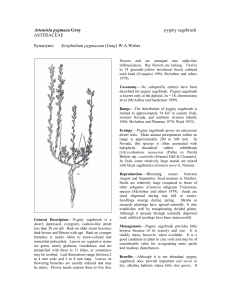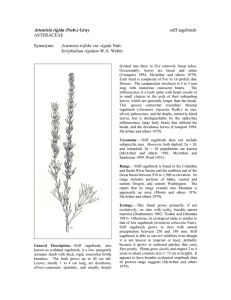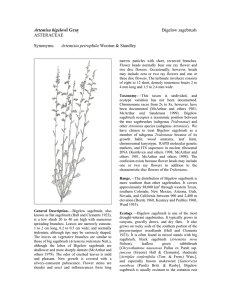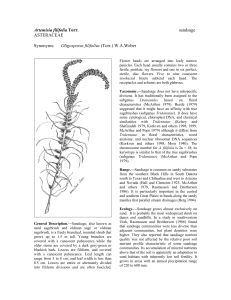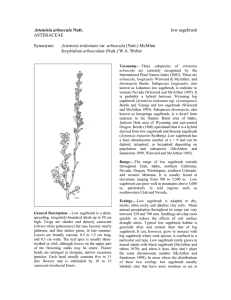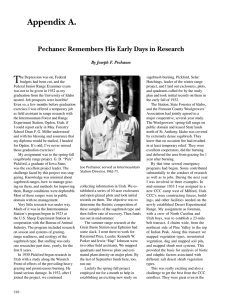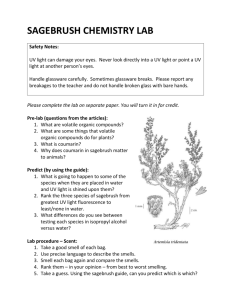Artemisia longiloba alkali sagebrush ASTERACEAE
advertisement
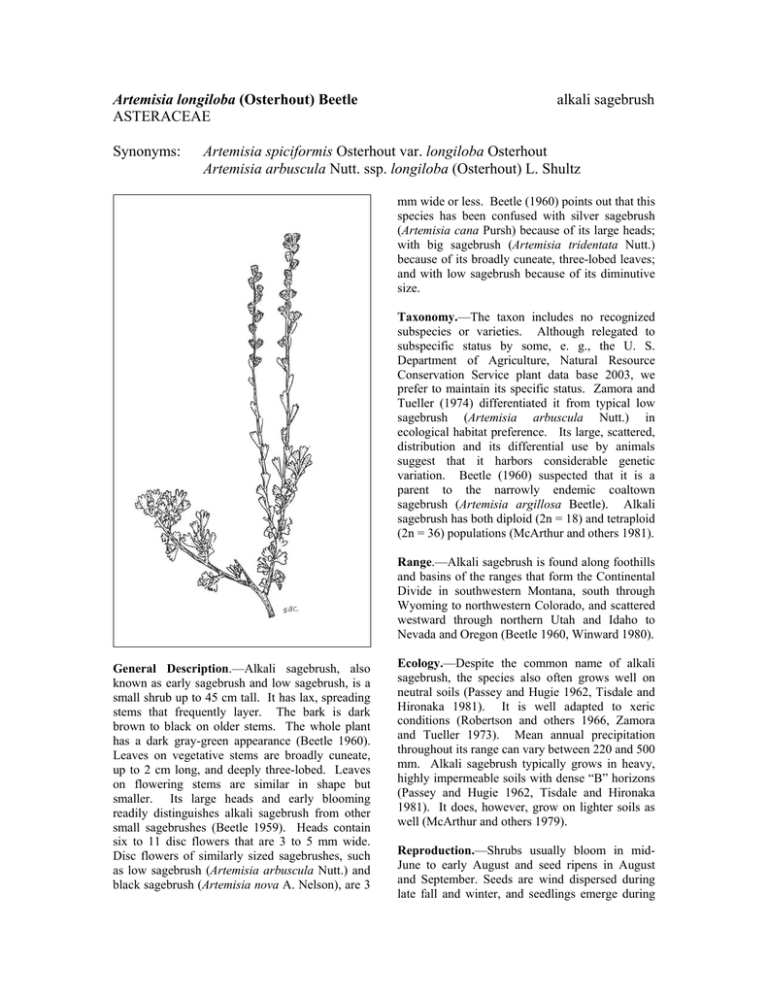
Artemisia longiloba (Osterhout) Beetle ASTERACEAE Synonyms: alkali sagebrush Artemisia spiciformis Osterhout var. longiloba Osterhout Artemisia arbuscula Nutt. ssp. longiloba (Osterhout) L. Shultz mm wide or less. Beetle (1960) points out that this species has been confused with silver sagebrush (Artemisia cana Pursh) because of its large heads; with big sagebrush (Artemisia tridentata Nutt.) because of its broadly cuneate, three-lobed leaves; and with low sagebrush because of its diminutive size. Taxonomy.—The taxon includes no recognized subspecies or varieties. Although relegated to subspecific status by some, e. g., the U. S. Department of Agriculture, Natural Resource Conservation Service plant data base 2003, we prefer to maintain its specific status. Zamora and Tueller (1974) differentiated it from typical low sagebrush (Artemisia arbuscula Nutt.) in ecological habitat preference. Its large, scattered, distribution and its differential use by animals suggest that it harbors considerable genetic variation. Beetle (1960) suspected that it is a parent to the narrowly endemic coaltown sagebrush (Artemisia argillosa Beetle). Alkali sagebrush has both diploid (2n = 18) and tetraploid (2n = 36) populations (McArthur and others 1981). Range.—Alkali sagebrush is found along foothills and basins of the ranges that form the Continental Divide in southwestern Montana, south through Wyoming to northwestern Colorado, and scattered westward through northern Utah and Idaho to Nevada and Oregon (Beetle 1960, Winward 1980). General Description.—Alkali sagebrush, also known as early sagebrush and low sagebrush, is a small shrub up to 45 cm tall. It has lax, spreading stems that frequently layer. The bark is dark brown to black on older stems. The whole plant has a dark gray-green appearance (Beetle 1960). Leaves on vegetative stems are broadly cuneate, up to 2 cm long, and deeply three-lobed. Leaves on flowering stems are similar in shape but smaller. Its large heads and early blooming readily distinguishes alkali sagebrush from other small sagebrushes (Beetle 1959). Heads contain six to 11 disc flowers that are 3 to 5 mm wide. Disc flowers of similarly sized sagebrushes, such as low sagebrush (Artemisia arbuscula Nutt.) and black sagebrush (Artemisia nova A. Nelson), are 3 Ecology.—Despite the common name of alkali sagebrush, the species also often grows well on neutral soils (Passey and Hugie 1962, Tisdale and Hironaka 1981). It is well adapted to xeric conditions (Robertson and others 1966, Zamora and Tueller 1973). Mean annual precipitation throughout its range can vary between 220 and 500 mm. Alkali sagebrush typically grows in heavy, highly impermeable soils with dense “B” horizons (Passey and Hugie 1962, Tisdale and Hironaka 1981). It does, however, grow on lighter soils as well (McArthur and others 1979). Reproduction.—Shrubs usually bloom in midJune to early August and seed ripens in August and September. Seeds are wind dispersed during late fall and winter, and seedlings emerge during the following spring. Seeds are about the size of low sagebrush seeds so we expect there would be about 2 million cleaned seeds per kg (Meyer 2003). Natural seeding occurs rapidly following fires and other disturbances, yet mechanical tillage can limit establishment if seeds are sown too deep or if the seedbed is disrupted (Monsen and Shaw 1986). Management.—Alkali sagebrush, depending on location and ecotype, can be a source of palatable browse for domestic sheep and provide habitat and forage for other animals (Dealy and others 1981, McArthur and others 1979). Stands of alkali sagebrush in good condition can support a diverse understory of perennial grasses and annual and perennial forbs. Such stands provide forage and cover for sage grouse, antelope, other wildlife, and domestic livestock (Dealy and others 1981, Monsen and Shaw 1986). Some stands, however, are much less diverse and provide little forage or habitat. Sites that lack a satisfactory understory remain closed unless shrubs are reduced by fire or other disturbance. Monsen and Shaw (1986) reported that decadent stands can be rejuvenated by mechanical means. This shrub has the potential to be a useful plant in rehabilitation, especially on heavy, seasonally dry soils. It has been observed invading roadcuts in Echo Canyon, Utah, and along roadsides near Kemmerer, Wyoming (McArthur and others 1979). Benefits.—Alkali sagebrush is a native shrub that provides habitat and forage for wildlife and livestock. In addition, it has characteristics that could make it useful in ecological restoration, rehabilitation, or soil conservation. It spreads well through natural seeding and tolerates disturbance. It also grows on argillic soils that may be too heavily textured for most other shrubs. References Beetle, A.A. 1959. New names within the section Tridentatae of Artemisia. Rhodora 61: 82-85. Beetle, A.A. 1960. A study of sagebrush, the section Tridentatae of Artemisia. Bulletin 368, University of Wyoming Agriculture Experiment Station, Laramie, WY. 83 p. Dealy, J.E., D.A. Leckenby, and D.M. Concannon. 1981. Wildlife habitats in managed rangelands: The Great Basin of southeastern Oregon. Plant communities and their importance to wildlife. General Technical Report PNW-120. U.S. Department of Agriculture, Forest Service, Pacific Northwest Forest and Range Experiment Station, Portland, OR. 66 p. McArthur, E.D., A.C. Blauer, A.P. Plummer, and R. Stevens 1979. Characteristics and hybridization of important intermountain shrubs. III. Sunflower family. Research Paper INT-220. U.S. Department of Agriculture, Forest Service, Intermountain Forest and Range Experiment Station, Ogden, UT. 82 p. McArthur, E.D., C.L. Pope, and D.C. Freeman. 1981. Chromosomal studies of subgenus Tridentatae of Artemisia: evidence for autopolyploidy. American Journal of Botany 68: 589-605. Meyer, S.E. 2003. Artemisia. In: Bonner, F.T., and R. Nisley, eds. Woody plant seed manual. http://www.wpsm.net. [not paged]. Monsen, S.B. and N.L. Shaw. 1986. Response of an alkali sagebrush/fescue site to restoration treatments. In: McArthur, E.D. and B.L Welch, comps. Proceedings—symposium on the biology of Artemisia and Chrysothamnus; 1984 July 913, Provo, UT. General Technical Report INT200. U.S. Department of Agriculture, Forest Service, Intermountain Research Station, Ogden, UT. p. 126-133. Passey, H.B. and V.K. Hugie. 1962. Sagebrush on relic ranges in the Snake River plains and northern Great Plains. Journal of Range Management. 15: 273-278. Robertson, D.R., J.L. Nielsen, and N.H. Bare. 1966. Vegetation and soils of alkali sagebrush and adjacent big sagebrush ranges in North Park, Colorado. Journal of Range Management. 19: 17-20. Tisdale, E.W. and M. Hironaka. 1981. The sagebrush—grass region: a review of the ecological literature. Bulletin No. 33, Forest, Wildlife, and Range Experiment Station, University of Idaho, Moscow, ID. 31 p. U. S. Department of Agriculture, Natural Resources Conservation Service— http//www.plants.usda.gov. Last visited August 25, 3003. Winward, A.H. 1980. Taxonomy and ecology of sagebrush in Oregon. Bull. 642. Oregon State University, Oregon Agricultural Experiment Station, Corvallis, OR. 15 p. Zamora, B. and P.T. Tueller. 1973. Artemisia arbuscula, A. longiloba, and A. nova habitat types in northern Nevada. Great Basin Naturalist. 33: 225-242. E. Durant McArthur and Jeffrey R. Taylor, Research Geneticist and Biological Technician, U.S. Department of Agriculture, Forest Service, Rocky Mountain Research Station, Shrub Sciences Laboratory, Provo, UT 84606-1856
